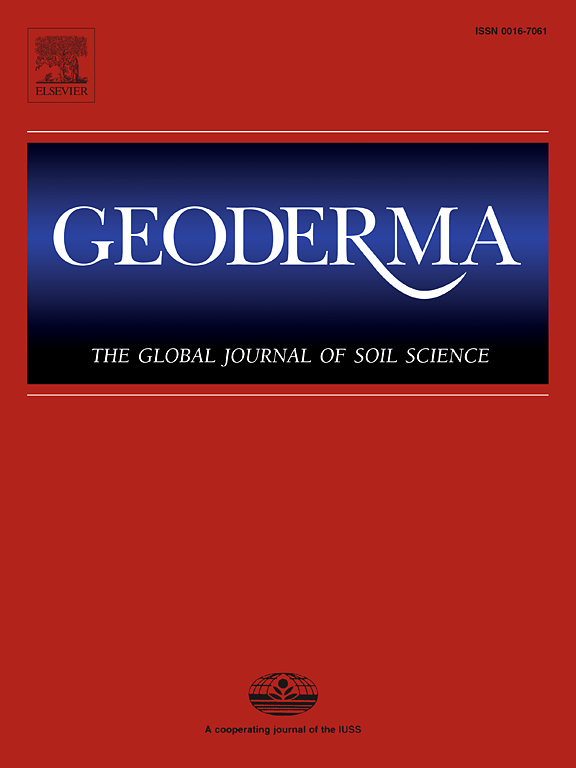不同分解阶段垃圾中锰积累的全球模式和影响因素--综述
IF 5.6
1区 农林科学
Q1 SOIL SCIENCE
引用次数: 0
摘要
锰(Mn)是木质素降解酶的重要辅助因子,对养分循环和生态系统功能至关重要。在枯落物分解过程中,锰可能会累积以满足微生物降解木质素等难降解物质的需求,这反映在分解枯落物中的锰含量与初始含量相比相对增加。然而,目前还没有在全球范围内对不同分解阶段影响锰行为的模式和因素进行量化。因此,我们系统地综合了 53 篇文献中的 1466 项观测结果,以评估不同分解阶段锰在垃圾中积累的总体模式和影响因素。我们的研究结果如下(1) 尽管各阶段之间存在一些差异,但全球范围内锰主要是在枯落物分解过程中积累的。值得注意的是,早期分解阶段(质量损失率为 40%)的锰累积量低于中期和晚期阶段。(2)在大部分分解过程中,枯落物质量和土壤特性是影响枯落物中锰积累的主要因素,只有在中期阶段(质量损失为 40-60 %),气候条件才与锰积累显著相关。(3)在分解的早期阶段(20-40%的质量损失),锰在枯落物中的积累受生态系统和植被类型的显著影响,湿地枯落物的积累高于高地枯落物,乔木枯落物的积累高于灌木枯落物。我们的研究定量地综合了不同分解阶段锰在枯落物中积累的全球模式和影响因素,从而加深了我们对不同生态系统和植被类型的全球锰循环和枯落物分解过程的理解。此外,这些发现强调了将锰的动态变化纳入全球枯落物分解动态模型的必要性。本文章由计算机程序翻译,如有差异,请以英文原文为准。
Global patterns and influencing factors of Mn accumulation in litter at different decomposition stages—A synthesis
Manganese (Mn) is an essential cofactor for lignin-degrading enzymes and crucial for nutrient cycling and ecosystem functions. During litter decomposition, Mn may accumulate to fulfill the microbial demand for degrading recalcitrant substances such as lignin, which is reflected in the relative increase in Mn in decomposing litter compared with its initial amount. However, a global-scale quantification of the patterns and factors influencing Mn behavior at different decomposition stages has not been conducted. Thus, we systematically synthesized 1,466 observations from 53 publications to assess the global patterns and influencing factors of Mn accumulation in litter across various stages of decomposition. Our findings are as follows: (1) Mn primarily accumulated during litter decomposition on a global scale, despite some variability among stages. Notably, Mn accumulation was lower in the early decomposition stage (<40 % mass loss) than in the intermediate and late stages. (2) Litter quality and soil properties were the primary factors influencing Mn accumulation in litter throughout most of the decomposition process, and climatic conditions were significantly correlated with Mn accumulation only in the intermediate stage (40–60 % mass loss). (3) During the early stage of decomposition (20–40 % mass loss), Mn accumulation in litter was significantly influenced by ecosystem and vegetation types, with higher accumulation observed in wetland litter than in upland litter and in tree litter than in shrub litter. Our study quantitatively synthesizes the global patterns and influencing factors of Mn accumulation in litter across different decomposition stages, thus enhancing our understanding of global Mn cycling and litter decomposition processes across different ecosystems and vegetation types. Furthermore, these findings highlight the necessity to incorporate Mn dynamics into global models of litter decomposition dynamics.
求助全文
通过发布文献求助,成功后即可免费获取论文全文。
去求助
来源期刊

Geoderma
农林科学-土壤科学
CiteScore
11.80
自引率
6.60%
发文量
597
审稿时长
58 days
期刊介绍:
Geoderma - the global journal of soil science - welcomes authors, readers and soil research from all parts of the world, encourages worldwide soil studies, and embraces all aspects of soil science and its associated pedagogy. The journal particularly welcomes interdisciplinary work focusing on dynamic soil processes and functions across space and time.
 求助内容:
求助内容: 应助结果提醒方式:
应助结果提醒方式:


